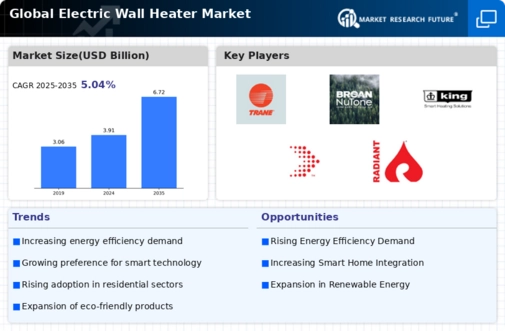Market Analysis
In-depth Analysis of Electric Wall Heater Market Industry Landscape
The electric wall heater market is set to reach US$ 5.8 BN by 2032, at a 5.80% CAGR between years 2023-2032. The market for electric wall heaters displays strong dynamics that are caused by several factors, which form its environment. The growing consciousness and the implementation of energy-efficient heating technologies is one of the major factors. With the growing awareness among consumers of their impact on climate and energy spending, electric wall heaters have become a very viable alternative due to its ability to convert electricity into heat. Technological developments in the electric heating systems also affect the market dynamics. Electric wall heaters are always evolving by the manufacturers to make them more effecient, safe and user friendly. Increasingly available smart features include programmable thermostats and remote controls, which meet the demands for heating solutions that are both simple to use yet also customizable. Energy-saving government programs and mandates are the essential components of the electric wall heater market. This phenomenon is very evident across the globe such that there is a lot of pressure towards lowering carbon emission and implementing green practices. This implies that consumers are motivated to purchase electric wall heaters which have high energy efficiencies; the manufacturers become competitive towards producing environment-friendly and also compliant products. The overall growth of the construction industry greatly affects the market dynamics. As more new residential and business buildings are being erected, the need for efficient heat supply solutions including electric wall heater increases at once. Besides the fact that renovations and enhancements in the existing buildings lead to market growth, as consumers seek contemporary and energy-efficient heating technologies. The changing trends of consumer preferences and also lifestyle influence the dynamic nature of electric wall heater market. The demand for minimal, space saving designs that can blend in well with different rooms including both the living room and also offices have made manufacturers come up with aesthetically appealing wall heaters. These heating solutions become even more advantageous with the ease of installation and also low maintenance costs. Market dynamics are greatly influenced by many factors such as competitive pricing and also cost affordability. Some high-end, feature rich electric wall heaters are targeted at a specific segment of the market and there is also an increasing demand for budget heating options with out compromising on the performance level. Manufacturers are responding to this shift by producing goods at various prices which creates more customers while also adding momentum into the larger market structure. The significance of global events and economic conditions cannot be dismissed at all when considering the market dynamics. The electrical wall heaters production, distribution, and also pricing are a product of the economic fluctuations supply chain disruptions and geopolitical factors.









Leave a Comment